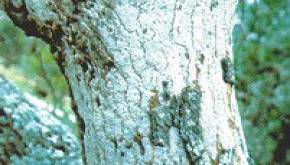
Drought Impacts: Hypoxylon Canker. The impacts of drought are often not immediately noticeable. Sometimes it might take a few years for the impacts to be seen in individual trees. Drought especially prolonged drought, stresses trees by reducing vigor, root development, and growth. Trees with reduced vigor are more susceptible to diseases and insects. Hypoxylon Canker, a fungal disease, attacks weakened hardwoods and can contribute to the death of the tree. Red oak species seem to be particularly susceptible to the disease. The disease can attack young and old trees alike.
I have a 12-year old oak that began showing symptoms of the disease last summer. A large, smooth grey surface developed on the trunk, followed by a large active "fungal mat” that spewed spores when I touched it. The fungal mat strongly resembled cocoa power: dark brown and very fine. I didn’t expect the tree to leaf out this spring but it did. Now, with this year’s drought, the tree is slowing dying. Branches are dying and the foliage is sparse and pale. I’ve seen other oaks on my property that appear to be suffering from the disease as well. What can I do as a landowner?
The most significant thing a landowner can do to help prevent this disease is to plant the tree species best suited to the site. Landowners should also pay attention to the number of trees per acre. Too many trees leads to too much competition for nutrients, light, water, and space. The USFS and several University Extension sites have good information available about this and other diseases. For more information go to:
http://www.fs.fed.us/r8/foresthealth/forestpests/diseases/hypox.shtml
http://www.uaex.edu/Other_Areas/publications/PDF/FSA-7557.pdf

